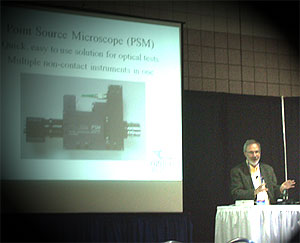
Point Source Microscope Unveiled
ROCHESTER, NY, May 13, 2009 – For alignment, imaging, autocollimation, non-contact profiling and radiometry, Optical Perspectives Group of Oregon introduced a point source microscope at the Optifab 2009 conference.
The product is an optical testing mechanism for various applications such as aligning optical systems, including inspecting optics and measuring the radius of curvature of surfaces because of its sharp perception of image shapes and point image location for aspheric optics and off-axis aspheres.
“Alignment really means putting features of a system where the design say’s they’re suppose to be,” said Robert Parks, cofounder of OPG – an optical fabrication and testing and optical metrology instrument prototyping facility. This will “effectively place [an] image exactly at the theoretical center.”

Robert Parks, cofounder of Optical Perspectives Group, presents his Point Source Microscope in a product demo presentation at Optifab 2009. The microscope is an important instrument for applications in alignment, non-contact profiling, radius measurement, optical aspherics, metrology and autocollimation. Photo by Amanda D. Francoeur.
By aligning an optical system, the spectrometer, mirrors and grating all have to line up. In doing so, their centers of curvature are placed on a common axis, specifically where the design specifies and all on-axis beams focus in the locations specified in the design, so as to keep the image centered in the field of the microscope. A Coordinate Measuring Machine (CMM) mechanically locates the center of curvature, while the PSM transfers the mechanical location to the center of curvature of the optical surface.
The microscope features a 100 mm tube lens objective and camera, a working distance over 20 mm and full field LED and laser diode point sources. Other alignment applications involve three-dimensional systems, telescope systems, atmospheric distortion correction systems, mold cavities for camera lenses of cell phones, holograms for aspheric testing, machined off-axis metal mirrors for terahertz optical systems and image slicer mirror arrays for astronomical spectrographs.
In a short course presented by OPG, two methods were described that involve an auto-stigmatic microscope, the point source - the tip of the laser diode, which helps to simplify optical alignment by using a laser tracking system. In order to do so, the microscope had to be precisely located at either the system conjugates or the centers of curvature. The former method described tracking the x, y, z coordinates of the focus of the objective, while the latter method tracked the objective focus and the pointing angle of the microscope. The second approach was found to accommodate complex systems by omitting the requirement for fixtures or alignment equipment, in addition to aiding in non-contact metrology.
Amanda D. Francoeur
[email protected]
/Buyers_Guide/Optical_Perspectives_Group_LLC/c10893